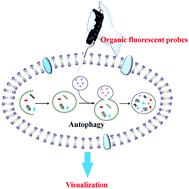当前位置:
X-MOL 学术
›
Chem. Soc. Rev.
›
论文详情
Our official English website, www.x-mol.net, welcomes your feedback! (Note: you will need to create a separate account there.)
Organic fluorescent probes for monitoring autophagy in living cells
Chemical Society Reviews ( IF 46.2 ) Pub Date : 2020-11-6 , DOI: 10.1039/d0cs00896f Xuechen Li 1, 2, 3, 4 , Xing Liang 1, 4, 5, 6, 7 , Junling Yin 1, 8, 9, 10, 11 , Weiying Lin 1, 4, 5, 6, 7
Chemical Society Reviews ( IF 46.2 ) Pub Date : 2020-11-6 , DOI: 10.1039/d0cs00896f Xuechen Li 1, 2, 3, 4 , Xing Liang 1, 4, 5, 6, 7 , Junling Yin 1, 8, 9, 10, 11 , Weiying Lin 1, 4, 5, 6, 7
Affiliation

|
As a ubiquitous degradation process in cells, autophagy plays important roles in various biological activities. However, the abnormality of autophagy is closely related to many diseases, such as aging, neurological disorder, and cancer. Thus, monitoring the process of autophagy in living cells has high significance in biological studies and diagnosis of related diseases. In order to real-time and in situ monitor the process of autophagy, various organic fluorescent probes have been explored in recent years owing to the advantages such as handy staining processes, flexible molecular design strategies, and near-nondestructive detection. However, this interesting and frontier topic has not been reviewed so far. In this tutorial review, we will focus on the latest breakthrough results of organic fluorescent probes in monitoring autophagy of living cells, especially the probe design strategies based on the several microenvironment changes of the autophagy process, and the responding mechanisms and bio-imaging applications in the autophagy process. In addition, we will discuss the shortcomings and limitations of the probes developed, such as susceptible to interference, unable to monitor the whole process, and lack of clinical applications. Finally, we will highlight some challenges and further opportunities in this field. This tutorial review may promote the development of more robust fluorescent probes to further reveal the mechanisms of autophagy, which is the basis of degradation and recycling of cell components.
中文翻译:

用于监视活细胞自噬的有机荧光探针
自噬作为细胞中普遍存在的降解过程,在各种生物学活动中起着重要作用。然而,自噬的异常与许多疾病密切相关,例如衰老,神经系统疾病和癌症。因此,监测活细胞自噬过程在生物学研究和相关疾病的诊断中具有重要意义。为了实时和原地监测自噬过程,由于其方便的染色过程,灵活的分子设计策略和近乎无损的检测等优点,近年来已探索了各种有机荧光探针。但是,到目前为止,尚未对此有趣而前沿的话题进行审查。在本教程中,我们将重点介绍有机荧光探针在监测活细胞自噬方面的最新突破性结果,尤其是基于自噬过程中微环境变化的探针设计策略,以及响应机制和生物成像应用。自噬过程。此外,我们将讨论开发的探针的缺点和局限性,例如易受干扰,无法监控整个过程以及缺乏临床应用。最后,我们将重点介绍该领域的一些挑战和进一步的机会。本教程审查可能会促进开发更强大的荧光探针,以进一步揭示自噬的机制,这是细胞成分降解和循环的基础。
更新日期:2020-12-09
中文翻译:

用于监视活细胞自噬的有机荧光探针
自噬作为细胞中普遍存在的降解过程,在各种生物学活动中起着重要作用。然而,自噬的异常与许多疾病密切相关,例如衰老,神经系统疾病和癌症。因此,监测活细胞自噬过程在生物学研究和相关疾病的诊断中具有重要意义。为了实时和原地监测自噬过程,由于其方便的染色过程,灵活的分子设计策略和近乎无损的检测等优点,近年来已探索了各种有机荧光探针。但是,到目前为止,尚未对此有趣而前沿的话题进行审查。在本教程中,我们将重点介绍有机荧光探针在监测活细胞自噬方面的最新突破性结果,尤其是基于自噬过程中微环境变化的探针设计策略,以及响应机制和生物成像应用。自噬过程。此外,我们将讨论开发的探针的缺点和局限性,例如易受干扰,无法监控整个过程以及缺乏临床应用。最后,我们将重点介绍该领域的一些挑战和进一步的机会。本教程审查可能会促进开发更强大的荧光探针,以进一步揭示自噬的机制,这是细胞成分降解和循环的基础。



























 京公网安备 11010802027423号
京公网安备 11010802027423号